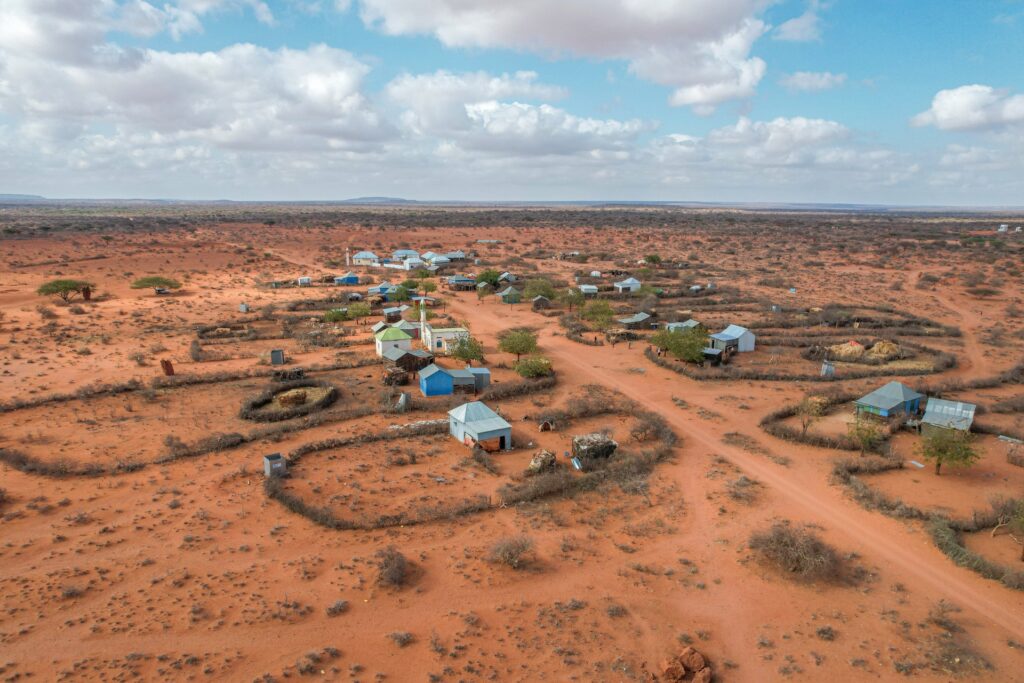In the Middle Shabelle region of Somalia, north of Mogadishu, Harqabobe village has long lived under the shadow of fear.
“When it rained, we worried what might come from the valley,” recalls local resident Huria.
“Would the water rise while we slept? Would it come without warning on a clear day?”
For years, the community endured a relentless cycle of extreme weather.
Torrential rains would sweep through the valley, destroying homes and fields.
When the rains ended, dry winds would trigger sandstorms, stripping topsoil and erasing fragile crops. Overgrazing and deforestation worsened the land’s decline, leaving the village vulnerable.
Working With Nature: The Turning Point
Today, however, the story has changed—thanks to a series of deliberate interventions by the community, supported by the International Organization for Migration (IOM) and the Somali non-profit Shaqadoon.
Instead of fighting nature, residents learned to work with it.
“Flood regulation structures were built to reduce flooding along the wadi bank,” explains Mahdi, a local organizer.
These structures guide water toward farmland, turning the once-destructive floods into a source of nourishment.
Crops now flourish where torrents once destroyed fields, and homes remain protected.

Community-Led Environmental Initiatives at Harqabobe Village
The transformation extends beyond infrastructure. Residents planted drought-resistant trees along the valley’s edge, creating a windbreak that softens sandstorms.
They also learned water management, erosion prevention, and soil conservation techniques.
“We learned about leadership, tree planting, wind control, and water management,” Mahdi says.
“Now we know how to use water efficiently and prevent erosion.”
Inclusive Planning and Collaboration
Community engagement has been central to this success.
Women, youth, and elders all participated in planning and implementing projects, turning a source of past disputes into a symbol of cooperation.
Half-moon basins, semi-circular trenches that capture rainwater, and bioswales now hold moisture, improve soil fertility, and allow vegetation to thrive even during dry seasons.
Visible Results in Harqabobe Village: From Destruction to Stability
Residents of Harqabobe village describe the results in visible terms.
Floodwaters now spread gently across fields, nourishing crops rather than washing them away.
Trees stabilize soil, calm the wind, and reduce dust.
Homes that were once abandoned now stand firm, and the village feels secure.
“Before, the wind carried away our soil, our homes, and our peace,” Huria says.
“During the rains, floods swept everything away. But now, we’ve returned to the homes we once left.
There is peace. There is stability. We believe the rains won’t bring fear anymore.”
A New Model of Humanitarian Aid
This approach also represents a shift in humanitarian aid, emphasizing prevention over repeated response. Instead of rebuilding after each disaster, Harqabobe village residents are now stewards of the land, turning potential destruction into productive harvests.
The initiative, funded by the European Union and implemented by IOM in partnership with Shaqadoon, illustrates how small, community-driven projects can transform the effects of climate change in vulnerable regions.
Hope Restored
By reading the land, understanding water flows, and using simple, nature-based solutions, Harqabobe village has found hope where once there was fear.
As Mohamed, a local resident, reflects, “Now there is hope again.”
The people of Harqabobe have not only protected their homes and crops—they have rewritten their story, showing how resilience, knowledge, and collaboration can turn the power of floods into a force for life.


